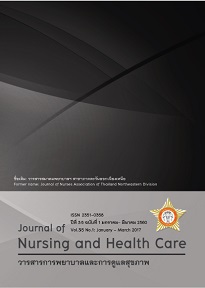การพัฒนาระบบการดูแลผู้ป่วยติดเชื้อในกระแสเลือดในผู้ป่วยหนัก โดยใช้การจัดการรายกรณี ในโรงพยาบาลสรรพสิทธิประสงค์ อุบลราชธานี The Development Caring System of Critical Sepsis Patients by Case Management at Sunprasithtiprasong Hospital, Ubon Ratchathani
คำสำคัญ:
การพัฒนา ระบบการดูแล ผู้ป่วยติดเชื้อในกระแสเลือด การจัดการรายกรณี development caring system critical sepsis patients case managementบทคัดย่อ
บทคัดย่อ
ภาวะติดเชื้อในกระแสเลือดเป็นภาวะแทรกซ้อนและทำให้ผู้ป่วยเสียชีวิต แม้ว่าจะมีแนวทางปฏิบัติการดูแลผู้ป่วยกลุ่มนี้แต่ยังพบว่า อัตราการตายยังสูงในผู้ป่วยหนัก การวิจัยครั้งนี้มีวัตถุประสงค์เพื่อพัฒนาระบบการดูแลผู้ป่วยติดเชื้อในกระแสเลือดในผู้ป่วยหนักโดยใช้การจัดการรายกรณี ในห้องผู้ป่วยหนัก โรงพยาบาลสรรพสิทธิประสงค์ อุบลราชธานี ใช้รูปแบบการวิจัยเชิงปฏิบัติการ (Action Research) เดือนพฤษภาคม 2558 ถึง กันยายน 2559 ดำเนินการศึกษา 3 ระยะ คือ 1) ระยะวิเคราะห์สถานการณ์ โดยการทบทวนเวชระเบียน และสังเกตการปฏิบัติการพยาบาลของพยาบาลวิชาชีพ 2) ระยะพัฒนาระบบการดูแลผู้ป่วยติดเชื้อในกระแสเลือด 3) ระยะประเมินผลการพัฒนาระบบ กลุ่มตัวอย่าง ประกอบด้วยทีมสหสาขาและพยาบาลวิชาชีพที่ให้การดูแลผู้ป่วยในห้องผู้ป่วยหนัก จำนวน 101 คน และผู้ป่วยติดเชื้อในกระแสเลือดก่อนและหลังพัฒนาระบบ จำนวน 79 คน และ 82 คน ตามลำดับ เครื่องมือประกอบด้วยระบบการดูแลผู้ป่วยติดเชื้อในกระแสเลือด ในผู้ป่วยหนัก โดยใช้การจัดการรายกรณี เก็บรวบรวมข้อมูลเชิงปริมาณ ใช้แบบเก็บรวบรวมข้อมูล และแบบสอบถาม วิเคราะห์ข้อมูลโดยใช้สถิติ เชิงพรรณนา การแจกแจงความถี่ ค่าเฉลี่ย ร้อยละ และสถิติการทดสอบที และไคร์สแควร์ เพื่อเปรียบเทียบผลก่อนและหลังการพัฒนาระบบ
ผลการวิจัย พบว่า ระบบการดูแลผู้ป่วยติดเชื้อในกระแสเลือดในผู้ป่วยหนัก โดยใช้การจัดการรายกรณี ประกอบด้วยระบบพยาบาลผู้จัดการรายกรณีโรคติดเชื้อในกระแสเลือด (CM sepsis) และประจำหอผู้ป่วย (NCM Sepsis) แนวทางการดูแลผู้ป่วย Sepsis และการใช้แนวปฏิบัติการพยาบาลผู้ป่วยติดเชื้อในกระแสเลือด ในการประเมินสภาพ การพยาบาลระยะเบื้องต้น เร่งด่วน ต่อเนื่องและเฝ้าระวังภาวะแทรกซ้อน รวมทั้งให้ข้อมูลผู้ป่วยและญาติ พยาบาลผู้จัดการรายกรณีมีบทบาทสำคัญในการให้ความรู้ เสริมพลัง นิเทศงานประสานการดูแลผู้ป่วยและแลกเปลี่ยนเรียนรู้ร่วมกับทีมสหสาขา ส่งผลให้เกิดผลลัพธ์ที่ดีหลังการพัฒนาระบบ ดังนี้ (1) อัตราการได้รับยาปฏิชีวนะของผู้ป่วยภายใน 1 ชั่วโมงหลังการวินิจฉัย เพิ่มขึ้นจากร้อยละ 68.8 เป็น 86.6 (p = 0.006) (2) อัตราการรักษาภาวะติดเชื้อในกระแสเลือดและทำให้ผู้ป่วยพ้นจากภาวะช็อก ภายใน 6 ชั่วโมงเพิ่มขึ้นจากร้อยละ 53.2 เป็น 61.0 (p = 0.30) (3) ระยะเวลานอนโรงพยาบาลของผู้ป่วย ลดลงจาก 11.9 เป็น 7.6 วัน (p = 0.003) ระยะเวลานอนห้องผู้ป่วยหนัก ลดลงจาก 7.6 เป็น 5.9 วัน (p = 0.18) (4) อัตราการตายของผู้ป่วยลดลงจาก ร้อยละ 31.6 เป็น 30.5 (p = 0.88) (5) อัตราการปฏิบัติตามแนวทางปฏิบัติการพยาบาลผู้ป่วยที่มีการติดเชื้อในกระแสเลือด เท่ากับร้อยละ 95.76 (6) คะแนนเฉลี่ยของความพึงพอใจของพยาบาลต่อแนวทางปฏิบัติการพยาบาลผู้ป่วยที่มีการติดเชื้อในกระแสเลือด เท่ากับ 16.54 คะแนน (จากคะแนนเต็ม 20)
ระบบการดูแลโดยใช้การจัดการรายกรณีที่พัฒนาขึ้นนี้ทำให้เกิดการประสานงานในทีมสหสาขาและทำให้ผู้ป่วยได้รับการดูแลอย่างรวดเร็ว ต่อเนื่อง ปลอดภัยและมีประสิทธิภาพ รวมทั้งทำให้มีการติดตามประเมินผลอย่างเป็นระบบจึงควรนำไปใช้ในการดูแลผู้ป่วยติดเชื้อในกระแสเลือดต่อไป
Abstract
Sepsis is a significant complication and cause of mortality. Although there are guidelines for caring of these patients, but also found that the death rate was high in intensive care units (ICUs). The objective of this research was to develop the care system for sepsis patients by case management in ICUs at Sanpasititprasong Hospital, Ubon Ratchathani. Action research design was conducted during May 2015 to September 2016. There were three phases of study including: 1) Situation analysis phase by reviewing patients’ medical records and the observing practice of nurses and health care team; 2) Development phase of caring system for sepsis patients; and 3) Evaluation phase of the development of caring system for sepsis patients. The participants were 101 of nurses and health care professional team that provided care in ICUs and 79, 82 sepsis patients before and after the system development respectively. The tools were the care system for sepsis patient by case management in intensive care units (ICUs), and questionnaires was used for quantitative data collection. Descriptive statistics were analyzed and reported as frequency, percentage, mean, standard deviation, and Pair independent t-test analysis and Chi-square was implemented to comparing the results between pre-and post the system development.
The results found that the caring system for critical sepsis patients by case management in intensive care units (ICUs) composed of the nurse case management system (CM sepsis) and nurse case manager at ward (NCM Sepsis), the sepsis management guideline and the nursing practice for sepsis patient’s guideline that to assessing, initializing, emerging, continuing, monitoring complications and giving information for patient and patients’ family. Nurse case managers play an important role in providing knowledge, empowerment, supervision, coordination, patient care with multidisciplinary teams. These impact on patient’s outcomes as follow (1) initial antimicrobial therapy within 1 hour of sepsis onset increased from 68.8% to 86.6% (p=0.006), (2) the infection therapy and resuscitate from septic shock within 6 hours increased from 53.2% to 61.0% (p=0.30),, (3) the length of stay (LoS) in the hospital decreased from 11.9 to 7.6 days (p=0.003), and LoS of ICUs decreased from 7.6 to 5.9 days (p=0.18),, (4) mortality rate decreased from 31.6% to 30.5.1% (p=0.88), (5) the sepsis bundle nursing guideline compliance increased to 95.76, and (6) the satisfaction of the sepsis bundle nursing guideline was 16.54 from 20.
This developed of caring system for critical sepsis patients by case management has led to coordinated multidisciplinary teams that providing patients fast, continuous, safe, effective care, and systematic monitoring that should be used to continuing care for sepsis patients.



